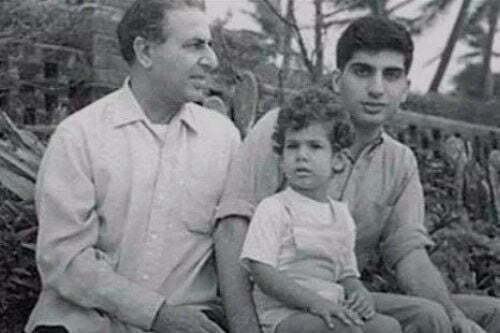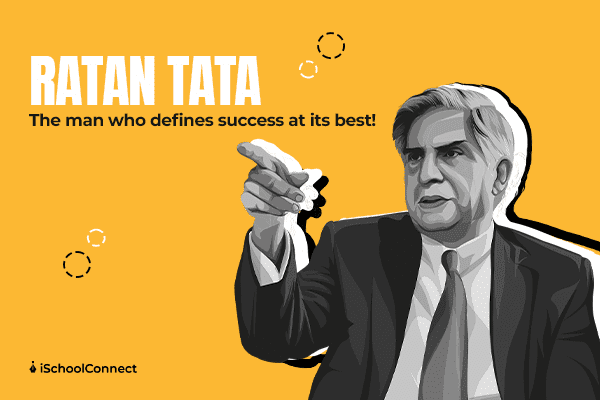Table of Contents
Ratan Tata is one of the most prominent business leaders of India. Despite running one of India’s largest conglomerates, he is greatly known for this generosity and kindness. He has always prioritized social and employee welfare before financial gains.
He oversaw the Tata Group, which includes approximately 100 companies with a combined sale of more than USD 67 billion. Under Tata’s incredible regime, the Tata Group scaled great heights, with sales and profits increasing over 50 times. Let’s have a look at his life narrative and explore the inspiring journey of Ratan Tata.
Childhood and early life

Ratan Tata was born in Mumbai, during the British Raj on 28th December 1937 to Naval and Sooni Tata. His parents belonged to one of the wealthiest business families in India, the Tata Group. The Tata family played a huge role in the industrial development of India post-independence.
Tata spent most of his childhood in India, under the care of his maternal grandmother after his parents’ divorce. He studied at the Campion School, Mumbai till eight grade. He then studied at Cathedral and John Connon School in Mumbai, the Bishop Cotton School in Shimla before moving to the United states for higher education. He graduated high-school from Riverdale Country School in New York City. He earned a management degree from Harvard University after studying architecture and structural engineering at Cornell University.
Despite becoming the future chairman of Tata Group, he began his career with blue-collar workers in the Tata Steel Division. In 1971, He was named Director-in-Charge of the National Radio and Electronics Company Limited (NELCO) when it was in desperate need of a resurrection, and he turned it around.
He took over the leadership of Tata Group in 1990, ushering in a slew of reforms to modernize the group’s business operations in order to compete successfully in the new era. During his tenure, he merged all Tata firms, purchased other companies such as Tetley and Jaguar Land Rover, and floated Tata Motors on the New York Stock Exchange, earning the company international acclaim.
Under his leadership, India acquired its first indigenously built automobile, the ‘Indica,’ as well as its first tiny car, the ‘Nano.’ As the world’s most economic automobile, the nano was designed specifically for nuclear families.
Achievements
Ratan Naval Tata was chairman of the Tata Group until his retirement in 2012, after which he served as temporary chairman in 2017. The industrialist has received two of the highest accolades given by the Indian government, the Padma Bhushan and the Padma Vibhushan.
Apart from Corus Group, one of Ratan Tata’s most notable accomplishments was taking the Tata brand global through acquisitions such as Tetley Tea, Daewoo Motors’ truck manufacturing subsidiary, and Jaguar Land Rover.
TCS, an IT services business, went public in 2004 under Ratan Tata’s leadership. TCS is the first Indian software company to cross $1 billion in revenue.
Tata Motors, the automaker, was listed on the New York Stock Exchange under Ratan Tata’s reign. Tata’s contribution to India’s car sector has been a feather in his cap, with the group building a true-blue Indian brand, the Indica, followed by the Nano, which was his own creation. During his tenure, the Tata Group’s revenues and net earnings more than doubled.
Overcoming the challenges

Ratan Tata had a significant task when he met with Ford executives to sell the Tata Group’s vehicle division. The acquisition did not go through, but Tata fought to improve the car industry. When Ford was on the verge of bankruptcy nine years later, Tata was able to secure the company’s Jaguar Land Rover purchase for more than $2 billion. This acquisition helped turn Tata group into a global business.
During the Mumbai 26/11 terror attacks, he spearheaded efforts to assist casualties outside the Taj hotel, demonstrating his ability to overcome every obstacle.
Ratan Tata’s philanthropic work
- Ratan Tata, a patron of education, medicine, and rural development, helped the University of New South Wales Faculty of Engineering supply better water to underserved communities.
- The Tata Education and Development Trust established a $28 million Tata Scholarship Fund, which will enable Cornell University to give financial help to Indian undergraduate students. At any one moment, the yearly award will assist roughly 20 students.
- In 2010, Tata Group enterprises and Tata charities gave $50 million to Harvard Business School (HBS) to build an executive centre. Tata Hall is located on the northeast side of Harvard Business School and stands seven stories tall and spans over 155,000 gross square feet.
- Tata Consultancy Services (TCS) has contributed $35 million to Carnegie Mellon University (CMU) for cognitive systems and autonomous vehicle research lab. It is the greatest corporate contribution ever, and the 48,000-square-foot structure is famous as TCS Hall.
- In 2014, the Tata Group contributed Rs. 950 million to the Indian Institute of Technology, Bombay, establishing the Tata Center for Technology and Design (TCTD). It was the greatest grant received by the institute in its history.
- Tata Trusts additionally donated a 750 million grant to the Indian Institute of Science’s Centre for Neuroscience to explore the processes underlying the etiology of Alzheimer’s disease and to develop ways for its early identification and treatment.
- In addition, the Tata Group established the MIT Tata Center of Technology and Design at the Massachusetts Institute of Technology (MIT) to address the difficulties of resource-constrained societies, with an initial focus on India.
Key takeaways
- Tata is a brilliant visionary who has always put compassion ahead of financial gains.
- His involvement is in several development and humanitarian projects to provide education and a better living in rural India.
- Throughout his career, he has garnered several accolades and distinctions. He received the highest civilian honors, the Padma Bhushan in 2000 and the Padma Vibhushan in 2008.
- He has received honorary degrees from the University of Warwick, Carnegie Mellon University, Ohio State University, the Asian Institute of Technology in Bangkok, and the University of New South Wales.
- His fortune is astonishing at GBP 300 million, although he owns less than 1% of the mammoth conglomerate of Tata Groups.
We hope this blog post was inspiring and informative. If you have any doubts, you can reach us here.
You can also share your thoughts by leaving a comment below.
Liked this blog? Read next: Top 5 motivational stories every student should know | Get inspired today!
FAQs
Q1. Does Ratan Tata have a pilot’s license?
Answers: Yes, he is a trained pilot and was the first Indian civilian to fly the F-16 Falcon fighter jet.
Q2. What is Ratan Tata’s position among the richest people?
Answer – Ratan Tata’s fortune, mostly derived from Tata Sons, stands at Rs 3,500 crore, placing him 433rd on the IIFL Wealth Hurun India Rich List 2021.
Q3. What did Ratan Tata study?
Answer– Ratan Tata is an extremely well-educated businessman. He has a Bachelor of Architecture degree from Cornell University in the United States and has completed an Advanced Management Program at Harvard Business School in the United States.







Great article about Ratan Tata. He is a great visionary and more than just a mere businessman. Kudos to the man!